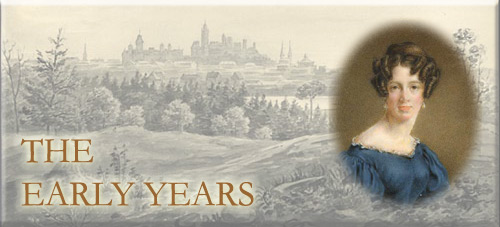
Table of Contents
Home | The Early Years | The Grand Tour | The Grand Tour- Continued
Britain - 1821-1837 | Miniatures on Ivory | Emigration - 1837
Settlement - 1837-1852 | Settlement - Continued | Peterborough and Toronto - 1852-1859
Britain & Canada: Tours and Vacations - 1860-1864 | Britain & Canada -1865-1878
Niagara, Ottawa, and Toronto - 1870s, 1880s
The Final Years | Langton Family and Family Connections | Preserving of the Collection
Resources and Acknowledgements
|
Anne Langton was born in 1804, into an aristocratic family at Farfield Hall, in the picturesque Yorkshire Dales. When Anne was just a few months old, the family moved to Lancashire. She was raised at Blythe Hall, an elegant mansion, near Ormskirk. With brothers William and John, Anne was educated at home by their parents, Thomas and Ellen, and private tutors, and raised according to upper class standards of her times. Such standards included the emerging cultural and social concept of "the gentlewoman," an unofficial code which defined the characteristics of upper and middle-class females. |
Click to see a larger image (70K) Farfield [Hall, North Yorkshire], [ca. 1834] Anne Langton Graphite on cream wove paper Reference Code: F 1077-9-1-19-3 Archives of Ontario, I0008470 |
|
|
||
Blythe Hall (parts of which dated back to the twelfth century), was the country mansion where Anne and her brothers spent their idyllic early childhood. It became the family's "ideal" home. They would carry the image of Blythe Hall with them emotionally wherever they went and, to some degree, tried to re-create it physically, when they settled in Upper Canada, some years later. This image is a preliminary sketch dated September 2nd, 1834. |
Click to see a larger image (62K) Blythe Hall, Lancashire, England, 1834 Anne Langton Graphite on cream wove paper Reference Code: F 1077-9-1-19-1 Archives of Ontario, I0008468 |
|
|
||
|
In 1815, when Anne was eleven, life at Blythe was halted when Thomas took his family on an extended European "Grand Tour" to expand the children's awareness, through arts, languages, literatures, travel. |
||
The Early Years | The Grand Tour | The Grand Tour- Continued
Britain - 1821-1837 | Miniatures on Ivory | Emigration - 1837
Settlement - 1837-1852 | Settlement - Continued | Peterborough and Toronto - 1852-1859
Britain & Canada: Tours and Vacations - 1860-1864 | Britain & Canada -1865-1878
Niagara, Ottawa, and Toronto - 1870s, 1880s
The Final Years | Langton Family and Family Connections | Preserving of the Collection
Resources and Acknowledgements
![Farfield [Hall, North Yorkshire], 183-(?)](pics/8470_farfield_hall.jpg)
![Blythe Hall,, Lancashire, England [c. 182?]](pics/8468_blythe_hall_sketch.jpg)